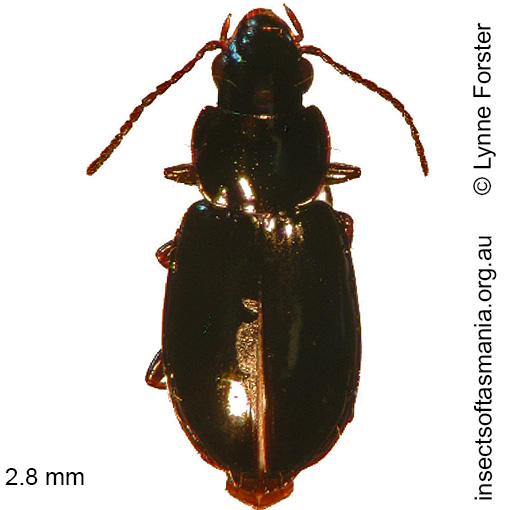
Amblystomus nigrinus (a species of ground-beetle)
Basis for Tasmanian occurrence
TMAG collections
Classification
Suborder: Adephaga
Superfamily: Caraboidea
Family: Carabidae
Subfamily: Harpalinae
Tribe: Harpalini
Morphology
Typical length (mm): 3
Flightedness: (not yet documented)
Ecology
Association with dead wood or old trees: not saproxylic
Ecological attributes: — Affliliated with young (ex-clearfelled) forest (Grove, 2009) — Dry sclerophyll forest can be suitable habitat (Michaels, 1999b).
Collection method(s) for TMAG material: — Emergence trapping from cut billets of Eucalyptus obliqua (Harrison, 2007) — Knockdown fogging of canopy of Eucalyptus obliqua — Pitfall trapping.
Source ecological literature:
Baker, S.C. (2006b). Ecology and conservation of ground-dwelling beetles in managed wet eucalypt forest: edge and riparian effects. PhD thesis, Univ. of Tasmania, Hobart.
Grove, S.J. (2009c). Do wildlife habitat strips act as refuges for mature-forest carabid beetle assemblages? A case-study in Tasmanian wet eucalypt forest, Australia. For. Ecol. Manage. 259: 496-504.
Harrison, K.S. (2007). Saproxylic beetles associated with habitat features in Eucalyptus obliqua trees in the southern forests of Tasmania. PhD thesis, Dept. of Zoology, Univ. of Tasmania, Hobart.
Michaels, K.F. (1999b). Carabid … communities in Tasmania: classification for nature conservation. In: Ponder, W. & Lunney, D. (Ed.), The Other 99%: …. Roy. Zool. Soc. NSW, pp. 374-379.


